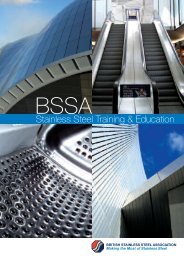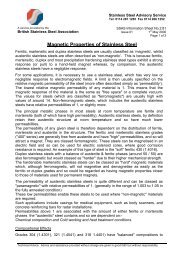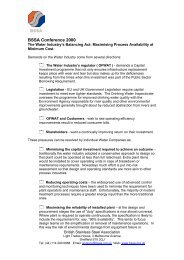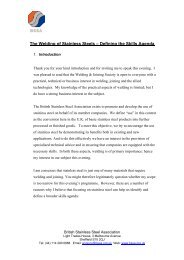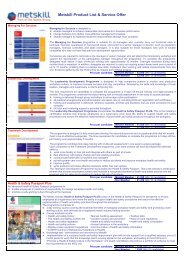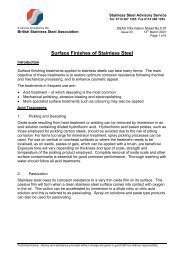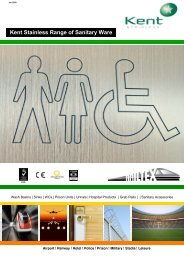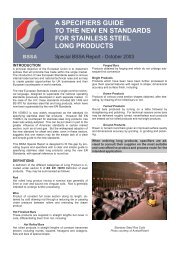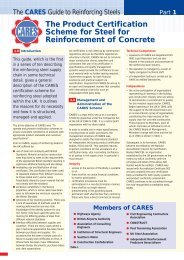Operational guidelines and code of practice for stainless steel
Operational guidelines and code of practice for stainless steel
Operational guidelines and code of practice for stainless steel
Create successful ePaper yourself
Turn your PDF publications into a flip-book with our unique Google optimized e-Paper software.
OGCP - Stainless Steel – DWI Ref 56.4.477 – OPERATIONAL GUIDELINES<br />
<strong>of</strong> contamination by the use <strong>of</strong> covers <strong>and</strong> end caps prior to final assembly.<br />
2 Temporary coverings should be used to protect assemblies from grinding, concrete <strong>and</strong><br />
masonry dust.<br />
3 As in the initial storage <strong>and</strong> fabrication stages, precautions should be taken to minimise<br />
contamination with iron particles, either as dust or spatter from cutting or sawing operations,<br />
or embedded by contact, <strong>for</strong> example as a result <strong>of</strong> scaffold poles being dragged over the<br />
metal.<br />
4 Any resulting incidental iron contamination may be readily removed by applying a nitric acid<br />
based cleaning agent, where contamination is superficial, or a pickling agent, where<br />
embedded. Proprietary <strong>for</strong>mulations are available.<br />
5 If surface dust contamination is heavy, <strong>stainless</strong> <strong>steel</strong> components should be thoroughly<br />
washed down during construction. In any case, it is preferred that plant should be washed<br />
down with drinking grade water at the end <strong>of</strong> installation operations.<br />
6 Pipework systems should be flushed through to remove any debris <strong>and</strong>, if left to st<strong>and</strong> empty<br />
prior to commissioning, washed with drinking water <strong>and</strong> dried xxxiv .<br />
Components should be prefabricated <strong>for</strong> mechanical fastening, taking advantage <strong>of</strong> the range <strong>of</strong><br />
conversion couplings available, or <strong>for</strong> tie-in welding. Pipework systems should be spooled. Spool<br />
pieces <strong>and</strong> pressure vessels joined with <strong>stainless</strong> <strong>steel</strong> connections should be bolted using compatible<br />
<strong>stainless</strong> <strong>steel</strong> bolts. Reference should be made to BS EN ISO 3506:1998 vi – Mechanical properties <strong>of</strong><br />
corrosion-resistant <strong>stainless</strong> <strong>steel</strong> fasteners.<br />
OG 4.3 Pipe burial<br />
See CP 4.3. If a risk assessment indicates that de-icing salt or other contamination may occasionally<br />
attack part <strong>of</strong> a buried pipe, then local protection <strong>of</strong> the pipe using suitable wrapping material should<br />
be considered by the Contractor.<br />
OG 4.4 Specialised protection, painting, minor fitments <strong>and</strong> insulation<br />
See CP 4.4. The risk <strong>of</strong> chloride-induced stress corrosion cracking (SCC) is addressed in Reference<br />
XXI xix , which outlines the selection <strong>of</strong> insulation <strong>and</strong> protection <strong>of</strong> pipework <strong>and</strong> tank systems that<br />
may operate at temperatures above about 50°C. Guidance on galvanic behaviour is also given in this<br />
reference.<br />
Initial surface preparation should observe the requirement to avoid contamination by iron. Thin gauge<br />
<strong>stainless</strong> <strong>steel</strong> surfaces may be distorted or damaged by conventional abrasive blasting operations that<br />
are normally used to provide a keying surface.<br />
SCI © 2002 26<br />
January 2002: Issue 1



